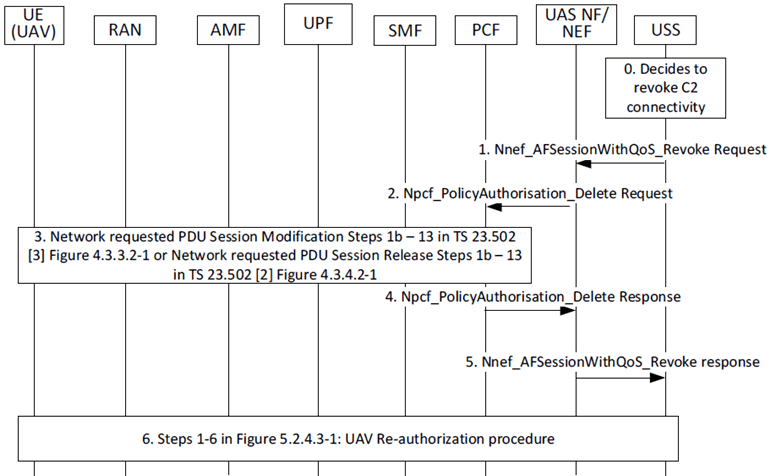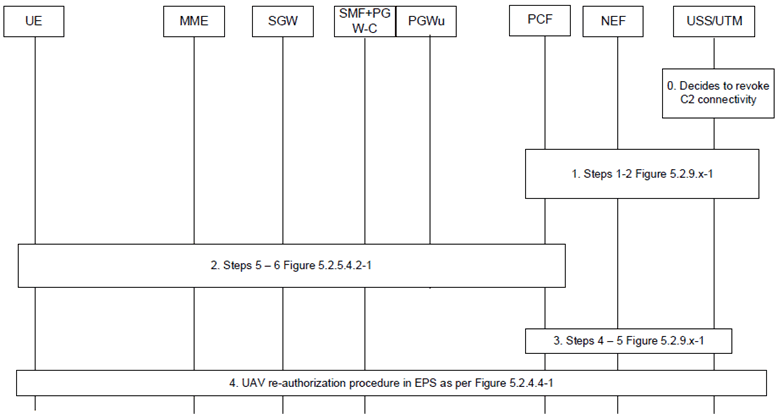Content for TS 23.256 Word version: 19.1.0
1…
4…
4.2…
4.2.3…
4.3…
4.4…
4.5…
5…
5.2.3…
5.2.4…
5.2.5…
5.2.5.3…
5.2.5.4…
5.2.7
5.2.8…
5.2.9…
5.3…
5.4…
5.5…
5.12…
5.13…
5.14…
6…
6.2…
6.3…
6.3.4…
A…
5.2.9 Revocation of C2 Connectivity
5.2.9.1 Revocation of C2 connectivity in 5GS
5.2.9.2 Revocation of C2 connectivity in EPS
...
...
5.2.9 Revocation of C2 Connectivity p. 58
5.2.9.1 Revocation of C2 connectivity in 5GS p. 58
When the USS decides to revoke an existing C2 connection between the UAV and UAV-C the USS invokes an Nnef_AFsessionWithQoS_Revoke request to NEF in order to revoke the AF request as described in Figure 5.2.9.1-1.

Step 0.
USS decides to revoke C2 connectivity.
Step 1.
USS identifies the AF session corresponding to the C2 connectivity and invokes an Nnef_AFSessionWithQoS_Revoke Request including USS identity/AF identifier, Transaction Reference ID.
Step 2.
UAS NF/NEF indicates to the PCF to delete the context of application level session information by invoking an Npcf_PolicyAuthorization_Delete request.
Step 3.
The PCF initiates a network requested PDU session modification procedures as in steps 1b-13 in Figure 4.3.3.2-1 of TS 23.502 removing the corresponding PCC rules installed at the SMF to support the AF session or may trigger a network requested PDU session release as in Steps 1b-13 Figure 4.3.4.2-1 of TS 23.502.
Step 4.
The PCF acknowledge the request by sending an Npcf_PolicyAuthorization_Delete response.
Step 5.
The UAS NF/NEF acknowledge the USS request by sending an Nnef_AFSessionWithQoS_Revoke response.
Step 6.
USS may invoke the UAV Re-authorization procedure in Figure 5.2.4.3-1 to deliver a C2 authorization payload indicating that C2 authorization has been revoked.
5.2.9.2 Revocation of C2 connectivity in EPS p. 59
The procedure is as follows:

Step 0.
USS decides to revoke C2 connectivity.
Step 1.
Steps 1 - 2 as described in Figure 5.2.9.1-1 are performed.
Step 2.
The PCF deletes policy information associated with the AF session and configures the resources and routing information as in steps 5 - 6 in Figure 5.2.5.4.2-1.
Step 3.
Steps 4-5 as described in Figure 5.2.9.1-1 are performed.
Step 4.
The USS may invoke the UAV re-authorization procedure in EPS as in Figure 5.2.4.4-1 to deliver a C2 authorization payload indicating that C2 connectivity is revoked.